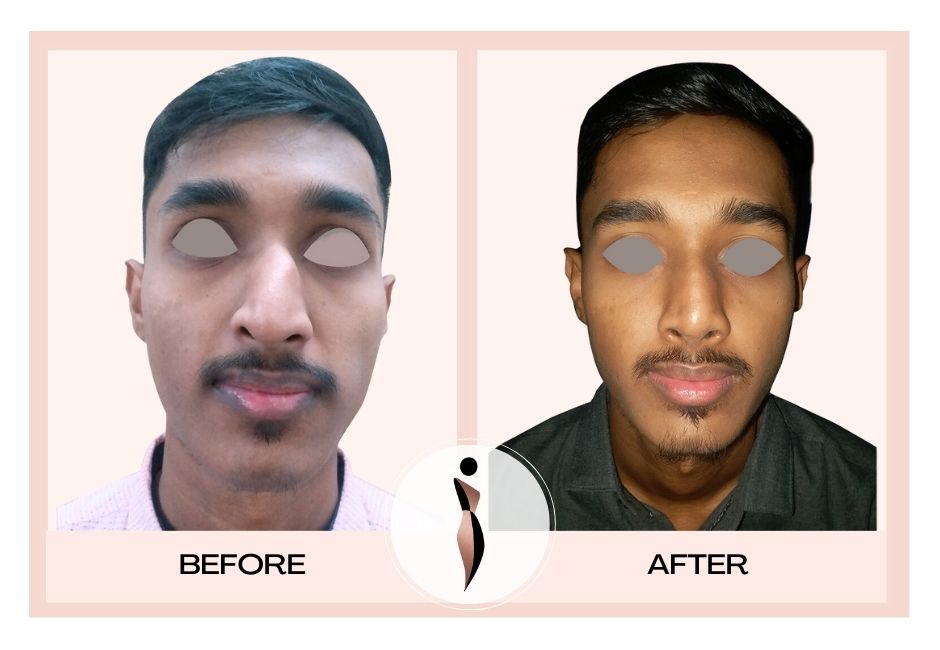
Rhinoplasty, commonly known as a nose job, is a surgical procedure aimed at correcting nose deformities. Dr. Amiti Shah specializes in addressing both physical and aesthetic issues related to the nose, ensuring that each patient achieves their desired look after Rhinoplasty Surgery in Mumbai.
The Procedure: Crafting Your Perfect Nose
The rhinoplasty procedure involves reshaping the bone and cartilage of the nose to achieve the desired appearance or correct functional issues. Dr. Amiti Shah employs advanced techniques tailored to each patient’s unique needs, ensuring optimal results.
- Open vs. Closed Rhinoplasty: Dr. Amiti Shah expertly performs both open and closed rhinoplasty techniques, selecting the most suitable approach based on individual anatomy and surgical goals.
- Common Concerns Addressed: From nasal humps to breathing difficulties, rhinoplasty can address a wide range of concerns, enhancing facial harmony and boosting self-confidence.
Post-Surgery Recovery and Results
While some discomfort and side effects are common post-surgery, Dr. Amiti Shah ensures a smooth recovery process with personalized care and guidance. Most patients resume their daily activities within a few weeks, reveling in their enhanced appearance.
What are the risks associated with rhinoplasty surgery in Mumbai?
The risks associated with rhinoplasty include a range of potential complications that patients should be aware of before undergoing the procedure. These risks can vary in severity and may include:
- Infection: Infections after rhinoplasty are rare but can manifest as pus-like discharge, swelling, and redness.
- Breathing Difficulties: Patients may experience temporary airway obstruction post-surgery, often due to swelling, nasal packs, or internal nasal splints.
- Altered Sense of Smell: Temporary loss of smell can occur after rhinoplasty, affecting taste as well.
- Bleeding: While significant bleeding is uncommon, minor bleeding or nosebleeds can occur.
- Poor Wound Healing or Scarring: There is a risk of poor wound healing, scarring, or unsatisfactory nasal appearance.
- Nasal Septal Perforation: A rare complication involving a hole in the nasal septum.
- Revisional Surgery: In some cases, additional surgery may be necessary to address unsatisfactory results.
- Skin Discoloration and Swelling: Patients may experience skin discoloration, swelling, and bruising post-surgery.
- Other Risks: Additional risks may include atrophy, fibrosis, numbness, cysts, and complications related to specific techniques used during the procedure.
It is crucial for individuals considering rhinoplasty to thoroughly discuss these risks with their plastic surgeon, understand the potential complications, and make an informed decision based on their personal goals and health considerations.
What is the success rate of rhinoplasty?
The success rate of rhinoplasty, also known as a nose job, is estimated to be between 85% and 90%. This success rate indicates the likelihood of achieving satisfactory results from the procedure. Additionally, the revision rate of rhinoplasty, which refers to the need for further corrective surgery, is reported to be between 10% and 15%. These statistics highlight the effectiveness of rhinoplasty in enhancing nasal aesthetics and functionality, with the majority of patients experiencing positive outcomes.
What factors affect the success rate of rhinoplasty?
Factors that can affect the success rate of rhinoplasty include:
- Choosing the Right Rhinoplasty Doctor: Selecting a skilled and experienced plastic surgeon specializing in rhinoplasty is crucial for achieving optimal results.
- Surgeon’s Expertise: The surgeon’s competence, experience, and expertise in nasal anatomy and surgical techniques play a significant role in the success of the procedure.
- Patient Expectations: Realistic expectations and clear communication between the patient and the surgeon are essential for a successful outcome.
- Patient’s Health: Factors like overall health, age, and lifestyle habits such as smoking can impact the success of rhinoplasty.
- Surgical Technique: The specific surgical approach used, whether open or closed rhinoplasty, can influence the results and recovery process.
- Combining Procedures: Combining rhinoplasty with other cosmetic surgeries may affect the risk of complications and the overall success rate of the procedure.
- Preoperative Assessment: Proper evaluation of the complexity of the rhinoplasty and the ability to predict postoperative results are crucial for achieving successful outcomes.
Considering these factors can help optimize the success rate of rhinoplasty and ensure a positive experience for patients seeking nasal enhancement.
Benefits Beyond Beauty: The Transformative Power of Rhinoplasty
Rhinoplasty offers more than just aesthetic enhancements; it can also improve breathing function and overall facial balance. Experience increased self-confidence and a newfound sense of harmony with your rejuvenated nose.
If you’re ready to embark on a transformative rhinoplasty journey in Mumbai, Dr. Amiti Shah is your trusted guide. With her unparalleled expertise and dedication to patient care, she ensures a seamless experience from consultation to recovery.
Don’t let your dream nose remain a fantasy – take the first step towards achieving it by booking an appointment with Dr. Amiti Shah today. Discover how her skillful hands can sculpt your ideal nose and redefine your confidence.
For more information on Rhinoplasty Surgery in Mumbai or to book a consultation with Dr. Amiti Shah, visit Shah Superspeciality Clinic or Contact us on +91 87795 36240 | 22-2367 7234 | 9820306981.
#cosmeticsurgeon#shah superspeciality clinic#bodycontouring#plastic surgeon in mumbai#dramitishah#dr. amiti shah#female plastic surgeon in mumbai#breastaugmentation#breastlift#breastreduction
